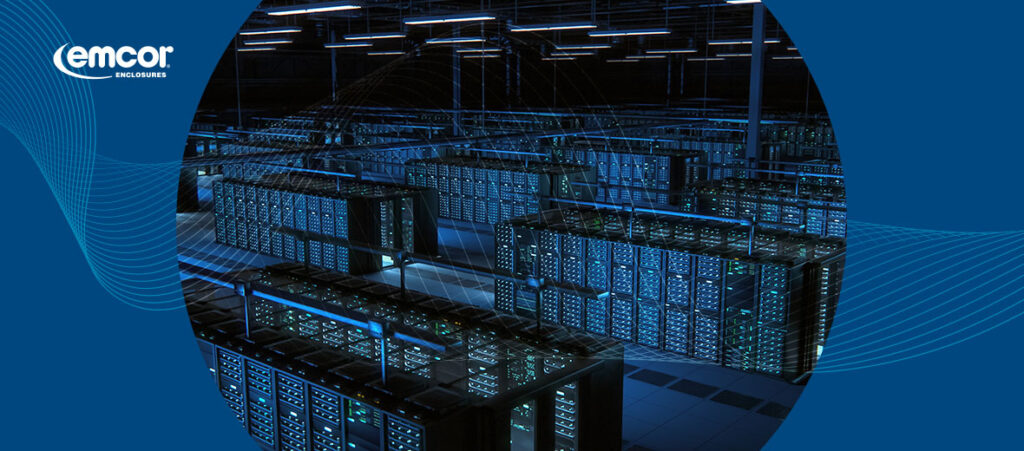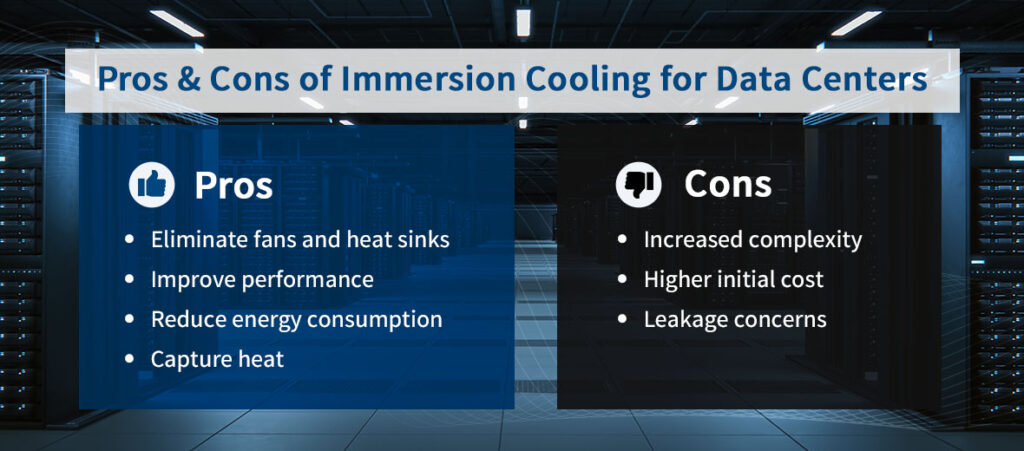Immersion Cooling for Data Centers

Data centers generate significant amounts of heat, and controlling it all can be challenging. Too much heat affects the performance and life span of components, and traditional cooling technologies increase energy consumption while taking up more space. Immersion cooling provides a solution. This liquid cooling technique offers exciting possibilities for the future of data centers, with improvements in efficiency, eco-friendliness and computing density.
Explore this cooling approach, the pros and cons of immersion cooling and important elements of the process.
What Is Immersion Cooling?
Immersion cooling is a type of liquid cooling in which the components, like servers and motherboards, or entire systems are completely submerged in an immersion cooling fluid. These dielectric fluids don’t conduct electricity, but they do conduct heat to carry away thermal energy without damaging the electronics.
As the components generate heat, the dielectric fluid captures and carries it toward a heat exchanger or water-cooled condenser coil. These technologies cool the fluid down and send it back to the system for reuse. Some data centers can even capture the heat and use it for other purposes.
While immersion cooling isn’t right for all businesses, it’s an ideal fit for the high-performance demands of data centers. It can support powerful, densely packed equipment and offer cost benefits for these complex environments.
Single-Phase vs. Two-Phase Cooling
Immersion cooling comes in two main varieties:
- Single-phase cooling: Single-phase cooling pumps the dielectric fluid to a heat exchanger, which cools it by bringing it into contact with a secondary liquid or air. These systems are more affordable and simpler, and the fluids used are often more eco-friendly.
- Two-phase cooling: A two-phase system relies on evaporation and a condenser coil. The hot components cause the fluid to turn into a gas and evaporate. The gas flows upward to a cold-water condenser that cools it and turns it back into a liquid, dripping down into the tank for reuse. Two-phase cooling uses power more efficiently than single-phase cooling, but is more expensive and harder to maintain.
Both cooling types offer significant advantages over conventional cooling methods. Traditional systems use active cooling equipment like fans and heat sinks to draw thermal energy away via ambient air. Server immersion cooling eliminates this equipment, which often comes with high energy consumption, noise and space constraints, especially in high-density environments like data centers.
Immersion cooling is also distinct from conductive liquid cooling, which moves the liquid through pipes and never directly touches the components, which can reduce its efficacy.
Pros of Immersion Cooling for Data Centers
Data centers that use immersion cooling can take advantage of wide-reaching benefits that affect everything from the space layout to energy consumption. The pros of immersion cooling include:
- Eliminate fans and heat sinks: This equipment is often inefficient, noisy and power-hungry. It also takes up considerable space, while immersion cooling systems are more compact and facilitate denser arrangements. By eliminating other cooling equipment, data centers can improve operations on several fronts.
- Improve performance: Many data centers need to support high-density and high-powered systems, and immersion cooling can keep up with demand and prevent overheating. Better cooling may even help improve the life span and performance of these electronics.
- Reduce energy consumption: Data centers alone account for up to 1.3% of global electricity demand with some countries spending as much as 18% of their electricity on data centers. Cooling systems use a lot of that power. With high efficiency and no active cooling equipment, immersion cooling can dramatically reduce energy consumption, helping data centers lower their environmental impact and save money.
- Capture heat: Most conventional cooling methods waste heat, but liquid cooling can capture it for other purposes, like heating buildings. For example, the Swedish government is using it to heat homes, reducing other energy demands. If you’re focused on environmental goals, data center liquid cooling could be an effective tactic.

Cons of Immersion Cooling for Data Centers
Due to its unique design, immersion cooling is usually best for larger data centers and businesses with high power demands. Here are some of the drawbacks of immersion cooling:
- Increased complexity: Since immersion cooling submerges the components, it requires unique maintenance skills. You must also monitor and replace the fluid regularly. This approach may result in the need for additional training or specialized services.
- Higher initial cost: Immersion cooling systems are more complex, so they typically cost more upfront. While the price tag might deter smaller businesses, the benefits of immersion cooling and the reduced operating costs make it an excellent investment, especially for high-power applications.
- Leakage concerns: A leaking immersion cooling system could cause drastic problems for a data center, flooding sensitive components with fluid. Any data center using this system must be proactive in monitoring for leaks and use high-quality enclosures to keep the fluid contained.
With careful planning and resource allocation, many data centers often find immersion cooling to be a cost-effective way to meet energy and performance goals.
Importance of Immersion Cooling Fluids
Water is much more thermally conductive than air, so it can absorb more heat in the same volume of space. But of course, water doesn’t mix well with electronics because it conducts electricity and has a low boiling point. Instead, we need to use fluids with different characteristics. The magic of immersion cooling is in the fluid that surrounds the components. Dielectric fluid is a unique material and crucial to the success of these systems.
Many single-phase systems use immersion cooling fluids made with hydrocarbons, like mineral, synthetic or biological oils, while two-phase immersion requires specially engineered fluids that contain fluorocarbons. They boil at low temperatures to enable evaporation.
Dielectric fluids or coolants are also non-corrosive, which ensures the components stay in good shape. Hydrocarbon-based fluids are usually biodegradable and non-toxic, making disposal easier and safer. Whatever form they take, dielectric coolants are a vital ingredient in immersion cooling.

Contact Us for Custom Immersion Cooling Enclosures
Another critical element in your immersion cooling system is the enclosure. Leaks can be problematic, and you’ll need an appropriately sized enclosure to reap the space-saving benefits of immersion cooling. A custom immersion cooling enclosure is the best way to incorporate this technology in your data center, offering the perfect fit and design to maximize efficiency.
Make the most of your immersion cooling system by pairing it with a custom enclosure from Emcor. We offer quick turnarounds and unparalleled customer service to protect your investment and optimize your cooling efforts. Contact us to request a quote and learn more about our customization capabilities.